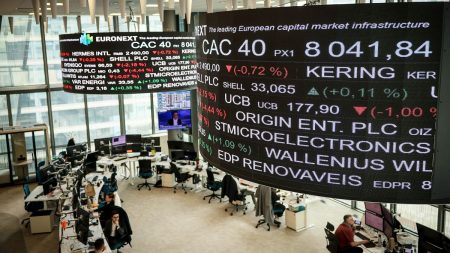European automakers experienced a significant decline in their share prices following Donald Trump’s announcement of potential tariffs on goods imported from China, Mexico, and Canada. On that particular Tuesday, the Volkswagen Group’s shares plummeted by 2.26%, settling at €80.40, while Stellantis saw a sharper drop of 4.54%, with shares trading at €12.24. Investors were apprehensive about the implications of these tariffs on the European market. Trump indicated plans to impose a substantial 25% tariff on all goods from Mexico and Canada, alongside a 10% tariff on those from China as part of his initial executive actions as president of the United States. This announcement heightened concerns over how escalating trade tensions could adversely affect the pricing of essential goods, including automobiles and food products, thereby potentially inflating costs within the US.
The implications of Trump’s proposed tariffs extend beyond mere stock fluctuations, posing significant risks to Europe’s economic stability. Analysts have expressed consensus that a 10% universal tariff on all US imports could disrupt European economic growth considerably. Such tariffs might exacerbate monetary policy divergence between the US and Europe, putting additional pressure on vital trade-sensitive sectors like automobiles and chemicals. The anticipated long-term consequences could further undermine Europe’s economic resilience, particularly if tariffs incite prolonged trade disputes. In such scenarios, the European Central Bank (ECB) may be compelled to take aggressive measures, such as slashing interest rates, to mitigate the economic fallout from these tariffs.
The impact of these tariffs is underscored by data released from the European Commission, highlighting that the European Union’s exports to the US reached €502.3 billion in 2023, accounting for one-fifth of all non-EU exports. This export landscape is dominated by machinery and vehicles, chemicals, and other manufactured goods, which collectively represent nearly 90% of the bloc’s transatlantic exports. Notably, the economic analyses indicate that economies heavily reliant on trade, such as Germany and the Netherlands, could be disproportionately affected. Forecasts from analysts at ABN Amro suggest that the imposition of tariffs could lead to a severe downturn in exports to the US, resulting in an estimated loss of approximately €260 billion, which translates to a 1.5 percentage point reduction in European growth based on projected GDP figures for 2024.
Should these tariffs materialize and negatively impact European economic growth, there is a strong likelihood that the European Central Bank will have to respond with drastic measures, possibly reducing interest rates to near zero by 2025. In contrast, the US Federal Reserve might continue to increase rates, leading to perhaps the most significant and prolonged divergence in monetary policy since the euro’s formation in 1999. Such discrepancies could weaken the euro, which might partially mitigate the competitive disadvantages facing European exporters; however, this would simultaneously escalate import costs, creating further economic challenges.
Economic analysts, such as Dirk Schumacher from Natixis Corporate & Investment Banking in Germany, emphasized the severity of the potential consequences stemming from a 10% tariff increase. Predictions indicate a potential reduction in GDP of approximately 0.5% in Germany, 0.3% in France, 0.4% in Italy, and 0.2% in Spain. The warnings issued suggest that persistent inflationary pressures and disruptions to trade relationships could lead to a recession within the euro area in response to escalating tariffs. As European nations grapple with these looming tariff threats, the risk of economic downturn looms large, suggesting a period of increased scrutiny and volatility ahead for the region’s financial markets and industrial sectors.
In summary, Trump’s threat of tariffs has sparked a chain reaction of concerns among European automakers and broader economic stakeholders, marking a pivotal moment in transatlantic trade relations. The potential for substantial financial losses, coupled with the risk of recession in key European economies, underlines the gravity of the situation. As investors and policymakers monitor developments closely, the prospect of heightened trade restrictions looms as a critical challenge for Europe’s economic landscape in the coming years, fundamentally altering the dynamics of international trade and economic growth. The interplay between US and European economic policies going forward will be crucial to watch, as it could set the stage for a new era of trade relations characterized by uncertainty and strategic recalibrations on both sides of the Atlantic.














